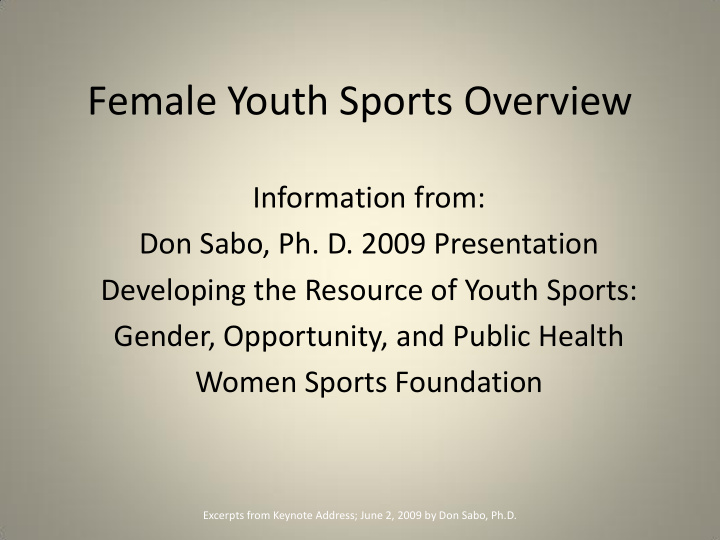



Female Youth Sports Overview Information from: Don Sabo, Ph. D. 2009 Presentation Developing the Resource of Youth Sports: Gender, Opportunity, and Public Health Women Sports Foundation Excerpts from Keynote Address; June 2, 2009 by Don Sabo, Ph.D.
Dr. Sabo’s presentation in 2009, in conjunction with the Women’s Sports Foundation, discusses many issues that are relevant to adolescent female sports participation. The following slides are from his presentation: • The Gender Gap in U.S. Youth Sports • Youth Sports Can Be An Educational Asset • Youth Sports: An Asset to Families • The “Sport Protection Hyposthesis” • Some Research Findings on Coorelates of Sports & Physical Activity for Girls and Women • The Social Context of Youth Development • Public Health Vision in Global Context; 1998 To review the entire presentation, go to: http://www.womenssportsfoundation.org/Content/Presentations/Research/Developing-the-Resource-of-Youth-Sports.aspx Excerpts from Keynote Address; June 2, 2009 by Don Sabo, Ph.D.
The Gender Gap in U.S. Youth Sports --More girls participate in sports than ever before. BUT… --A gender gap stretches across youth sports that favors males over females, sons over daughters. --The width of the gender gap is not uniform, however, and it varies across grade levels, communities, income levels, and racial and ethnic groups. -- The gender gap is widest in America’s urbancommunities. Excerpts from Keynote Address; June 2, 2009 by Don Sabo, Ph.D.
Youth Sports Can Be An Educational Asset •Athletes often get better grades. •Lower drop -out rates for many athletes compared with non- athletes. •The Hispanic female athlete “success story.” •Female athletes involved with school and community activities. •Athletes more likely to attend college after high school. •Female college athletes do better academically. Excerpts from Keynote Address; June 2, 2009 by Don Sabo, Ph.D.
Youth Sports: An Asset to Families •Children’s participation in organized sports is associated with greater family satisfaction. •This statistical finding holds for bothdual -parent and single- parent families. Excerpts from Keynote Address; June 2, 2009 by Don Sabo, Ph.D.
The “Sport Protection Hypothesis” Women athletes in U.S. universities less likely than non-athletes to say that they were sexually victimized. Fasting, K., Brackenridge, C. H., Miller, K. E. and Sabo, D. (2008). “Participation in college sports and protection from vi cti mization.” International Journal of Sport and Exercise Psychology, 6: 427-441. Excerpts from Keynote Address; June 2, 2009 by Don Sabo, Ph.D.
Some Research Findings on Correlates of Sports & Physical Activity for Girls and Women •Cardiovascular conditioning •Reduced risk for estrogen -dependent cancers •Lowered risk for obesity •Lower risk for Alzheimer’s and related dementias •Reduced risk for suicide •Less likely to smoke •Elevated emotional and psychological well -being •Combats depression •Self -reported quality of life •Elevation of body -esteem Excerpts from Keynote Address; June 2, 2009 by Don Sabo, Ph.D.
The Social Context of Youth Development •Youth sports unfolds within a constellation of institutions and social conditions. •Youth sports are part of the larger “convoy of social support” that includes family, schools, clubs, community, church-based organizations, nonprofits, and economic resources. Excerpts from Keynote Address; June 2, 2009 by Don Sabo, Ph.D.
Public Health Vision in Global Context “In recent decades, the sports industry, the sports media, and sports competitions have become international. How this globalization will reshape the perceptions, experiences, and practices associated with girls’ and women’s sports in various countries will be important to understand. Youth advocates, program planners, and those concerned about the health of girls should begin to experiment with a variety of programming approaches, including sports, as a way of supporting girls in their transition to adulthood.” Martha Brady (1998), Laying the foundations for girls’ healthy futures: Can sports play a role? Studies in Family Planning, vol. 29, #1, pp. 79-82. Excerpts from Keynote Address; June 2, 2009 by Don Sabo, Ph.D.
Recommend
More recommend